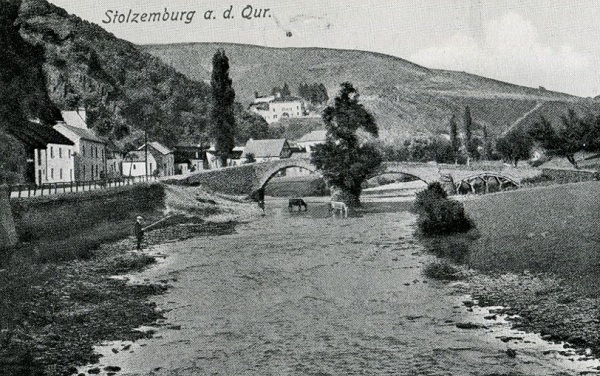 Stolzembourg in the late 19th century; according to David Heal, it would have looked much the same in 1944;
Credit: Provided by David Heal
Stolzembourg in the late 19th century; according to David Heal, it would have looked much the same in 1944;
Credit: Provided by David Heal
Chronicle.lu has teamed up with local author and tour guide David Heal of Luxembourg Battles for a historical series marking the 80th anniversary of the Battle of the Bulge.
Over the coming weeks, this series will look at how various villages and towns were involved and where one can go to see what happened.
Next up is Stolzembourg. To find this village, go north from Vianden, first of all skirting Bivels (more on this village later) and then going past the Pump Storage Scheme (the biggest in the world). Upon arrival in the village, stop at the crossroads by the bridge into Germany.
As David explained, the entire river from here down to Vianden was rebuilt when the pump storage scheme was created, so nothing looks at all what it would have resembled in 1944. However, this marks the place where the US army first crossed into Germany. There is a big memorial here, but the last time David was there it was hidden behind some builder's huts.
On 9 September 1944, US army units came down the road which lies between the houses on the left of the photograph and crossed the bridge into German. They went up the hill and found the West Wall fortifications, and they were empty. The German army had left them. They came back and reported to their HQ where the main interest was that they had crossed into Germany, and in writing a press release to tell the world about this. Nothing was done to advance and occupy the fortifications. When, eventually, a couple of days later, the US army went to have another look at the fortifications, the German army had come back. Just imagine what might have been had they advanced immediately that they were found to be unoccupied, noted David. They could have been used as a base to advance further, and to roll down the West Wall taking all the fortifications from the side and rear. David added that there would probably have been no Battle of the Bulge, and the Allies might well have got to Berlin long before the Russians, with all that would have implied for the years after 1945.
Today, the remains of the fortifications can still be found. Drive up the hill to the right ("fairly steep" and "very windy"). David noted that it takes him an hour to walk, and about ten minutes in a car. At the top there is a T junction. The area before the junction would have been covered in minefields and barbed wire. But where were the forts? Look carefully across the road, and to right and left at regular intervals there are small areas covered in brush and stunted trees. They cover the pill boxes, machine gun posts and the rest. After the war, the armies simply put dynamite in them, blew them up, and let nature take its course. The trees, etc. are the result.
Now, returning to the subject of Bivels. Until the rebuilding of the river, Bivels was a small village by the side of the river. Once Luxembourg had been liberated in September 1944, the village was evacuated because it was directly on the front line, and the occupant taken to the Vianden area. In early December, it became exceedingly cold, and one mother and her teenage son got permission to go back to the village to fetch winter clothes. When they got there, they bumped into a German patrol that had crossed the river (there was and is a footbridge across). They ran away, but the mother was captured and taken to Bitburg where she was interrogated to see what she knew about the defences - nothing. The Gestapo then told her to find somewhere to stay, come back the next day to report where she was and stay in the town. Instead, she walked off back to Luxembourg.
On her way to Bitburg, she had noticed lots of minefields, etc. on the slopes above Bettel, and on the way back that lots of horse drawn wagons were advancing along the roads with the horses' feet muffled. The minefields had gone and she was easily able to get back across to Bettel and then Vianden.
She reported to the US army there and told her story. They sent her to Diekirch, and then on to Bastogne. At some stage, someone changed her status from Luxembourgish to German and her story was ignored by the US army. Thus, yet again, prior notice of the attack was ignored, stated David.
Unrelated to the war, there is a memorial today near the church in Bivels dedicated to the men killed while rebuilding the river.








